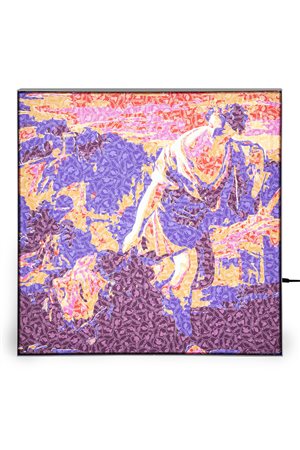 Wannenes - Via Albaro 11, 16145 Genova
Wannenes - Via Albaro 11, 16145 Genova
PHYGITAL PHYGITAL
giovedì 30 maggio 2024 ore 15:45 (UTC +01:00)
PIETRO MARELLI, IN ARTE PITMARELS
PIETRO MARELLI, IN ARTE PITMARELS
Cantù, 1996
This Is Not Caravaggio
Fake Machine
Il lotto comprende:
Dipinto a tecnica Sticking Detach su supporto retroilluminato / Sticking Detach painting on backlit support 50 x 50 cm
Non - Fungible Token / Video 3D realizzato in collaborazione con Adriano Lombardo / 3D video made in collaboration with Adriano Lombardo
Artista:
Pitmarels, pioniere della tecnica Sticking Detach, attraverso la fruizione degli stickers come medium principale della sua produzione, crea immagini che pongono al centro del suo lavoro il concetto di falsa apparenza. Le sue opere, infatti, possono e devono essere lette cambiando continuamente prospettiva. Partendo da una visione d’insieme, dove l’opera si mostra nella sua interezza, si arriva ad una visione più ristretta dove emergono tutti i dettagli che la costituiscono. Il concetto di falsa apparenza, approfonditamente studiato, riflette la presenza pervasiva di questa tematica nella vita quotidiana. L’artista sceglie l’adesivo come forma espressiva e personale cifra stilistica, diventando il suo pennello, la sua tela e il suo colore.
Adriano Lombardo nato a Milano il 24 aprile 1990, laureato con lode all'Accademia di Belle Arti di Brera a Milano, si distingue come un artista visivo che esplora con profondità le interazioni tra uomo, tecnologia e ambiente. Le sue opere, quali Interconnection e Sincronie Cerebrali , rappresentano fusioni innovative tra arte e scienza, offrendo esperienze coinvolgenti e all'avanguardia.. La sua ricerca artistica offre una prospettiva unica sulle interazioni complesse che compongono la realtà, continuando a ispirare e a sfidare il pubblico con esempi significativi di innovazione artistica contemporanea.
Artist:
Pitmarels, a pioneer of the Sticking Detach technique, uses stickers as the main medium of his production to create images that place the concept of false appearance at the centre of his work. His works, in fact, can and must be read by constantly changing perspective. Starting from an overall view, where the work is shown in its entirety, one arrives at a narrower view where all the details that constitute it emerge. The concept of false appearances, studied in depth, reflects the pervasive presence of this theme in everyday life. The artist chooses the sticker as his form of expression and personal stylistic signature, becoming his brush, his canvas and his colour.
Adriano Lombardo was born in Milan on 24 April 1990 and graduated with honours from the Brera Academy of Fine Arts in Milan. He stands out as a visual artist who deeply explores the interactions between man, technology and the environment. His works, such as 'Interconnection' and 'Sincronie Cerebrali', represent innovative fusions of art and science, offering immersive, state-of-the-art experiences. His artistic research offers a unique perspective on the complex interactions that make up reality, continuing to inspire and challenge audiences with significant examples of contemporary artistic innovation.
Dipinto:
This is Not Caravaggio racchiude tutto il processo di sperimentazione dell’artista. Gli stickers che compongono ogni suo lavoro rimandano immediatamente al simbolo della Chiquita, ma una volta osservata l’opera da vicino si scopre il vero adesivo, privo di identità, dove si legge la scritta Caravaggio. L’artista fruisce di una provocazione consapevole, mediante la quale ha voluto rappresentare Davide con la testa di Golia (Giovanni Lanfranco) sebbene da lontano l’opera appare come se fosse un quadro di Caravaggio. Osservando l’immagine più da vicino appare una costellazione di adesivi che alimentano una ricercata illusione. Al contempo, sebbene la scritta all’interno di ogni singolo adesivo sia la medesima, i soggetti presenti al suo interno variano, con l’intento di invitare lo spettatore a porsi delle domande e a creare un individuale percorso estetico ed interiore.
Non - Fungible Token:
Fake Machine nasce dalla collaborazione dei due artisti Pitmarels e Adriano Lombardo che hanno sentito la necessità di indagare il passato mediante una chiave futurista. Partendo dal concetto di falsa apparenza di Pitmarels e dalla rivisitazione delle iconografie del passato attraverso l'uso dello sticker, si arriva alla creazione di un soggetto che assume le sembianze di un cyborg all'interno di un contesto reale quanto fantascientifico. L'opera invita lo spettatore a tuffarsi in una dimensione ricca di pathos e pone delle forti riflessioni sul labile confine tra uomo e macchina, fisico e digitale, realtà e apparenza.
Painting:
This is Not Caravaggio encapsulates the artist's entire process of experimentation. The stickers that make up each of his works immediately refer to the Chiquita symbol, but once the work is observed up close, one discovers the real sticker, devoid of identity, where the words Caravaggio can be read. The artist uses a conscious provocation, by which he wanted to represent David with the head of Goliath (Giovanni Lanfranco), although from a distance the work appears as if it were a Caravaggio painting. Observing the image more closely, a constellation of stickers appears, feeding a deliberate illusion. At the same time, although the writing inside each sticker is the same, the subjects within it vary, with the intention of inviting the viewer to ask questions and create an individual aesthetic and inner journey.
Non - Fungible Token:
Fake Machine is the result of a collaboration between two artists, Pitmarels and Adriano Lombardo, who felt the need to explore the past through a futuristic key. Starting from Pitmarels' concept of false appearances and revisiting the iconographies of the past through the use of stickers, they arrive at the creation of a subject that takes on the appearance of a cyborg in a context that is as real as it is sci-fi. The work invites the viewer to plunge into a dimension rich in pathos and poses strong reflections on the blurred boundaries between man and machine, physical and digital, reality and appearance.




